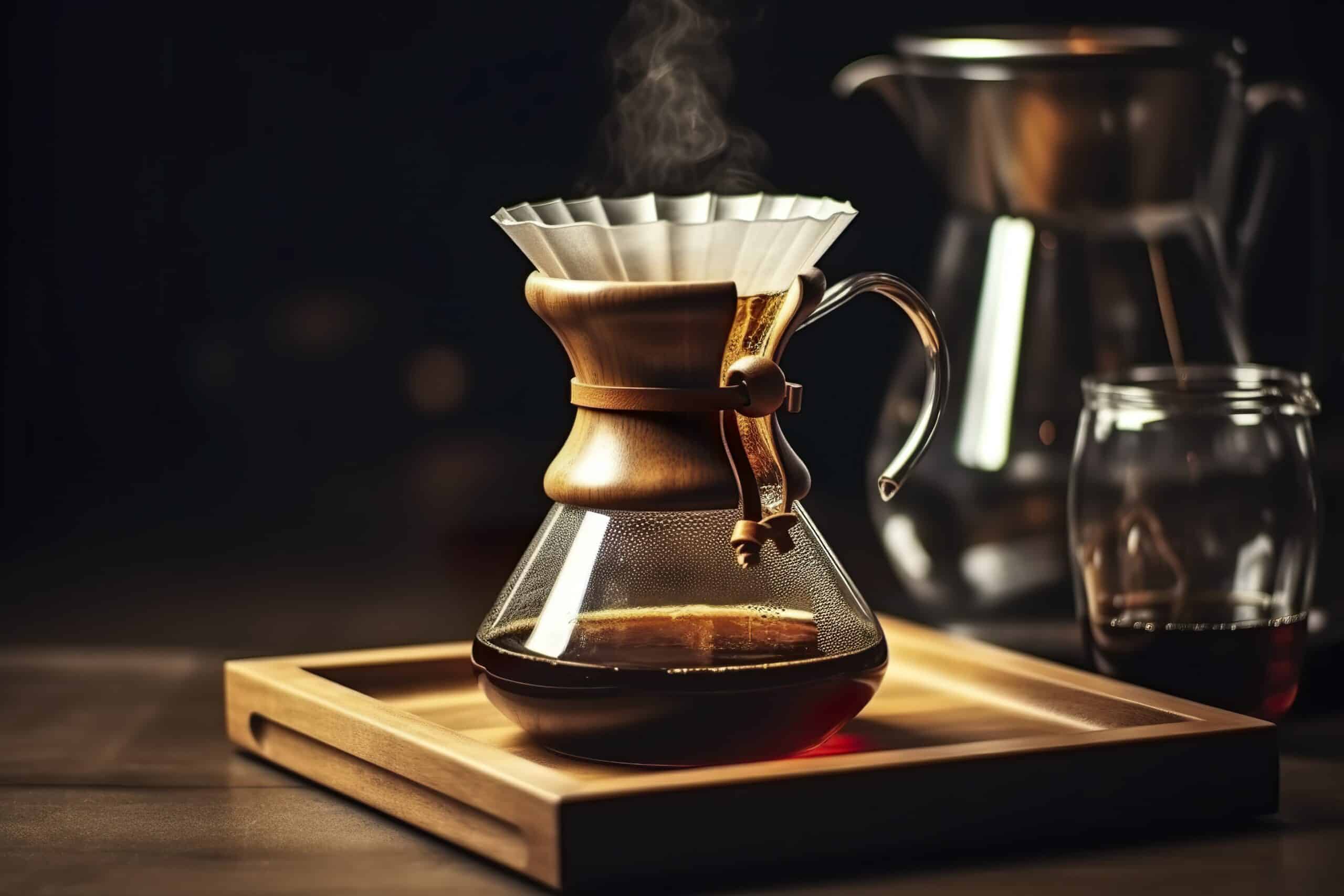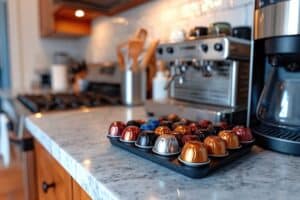What Is a Pour Over Coffee Maker?
Key Takeaways
- A pour over coffee maker is a manual brewing device that allows for precise control over various brewing parameters.
- The key steps to using a pour over coffee maker include grinding the coffee beans to the desired size, measuring the coffee-to-water ratio, and heating the water to the optimal temperature.
- There are different types of pour over coffee makers available, such as the Chemex, Hario V60, and Kalita Wave, each with its own unique design and brewing characteristics.
A pour over coffee maker is a brewing device that allows you to make coffee by pouring hot water over ground coffee beans placed in a filter. It is a manual brewing method that requires attention to detail and allows for precise control over various brewing parameters. By following specific steps and using the right equipment, you can create a flavorful and aromatic cup of pour over coffee.
The Process of Using a Pour Over Coffee Maker
Using a pour over coffee maker involves several key steps to ensure optimal taste and extraction:
1. Grind the Coffee Beans
The first step is to grind your coffee beans to the desired size. The grind size can vary depending on personal preference and the specific pour over coffee maker being used. Generally, a medium to medium-fine grind works well for most pour over methods. A good coffee grinder is essential for achieving a consistent grind size.
2. Measure the Coffee-to-Water Ratio
Next, measure out the correct ratio of coffee grounds to water. This ratio can vary depending on personal preference, but a common starting point is 1:16, which means using 1 gram of coffee for every 16 grams of water. Using a scale to measure the coffee and water ensures accuracy and consistency.
3. Heat the Water to the Optimal Temperature
Heat your water to the optimal temperature for brewing, which is typically between 195°F and 205°F (90°C to 96°C). This temperature range allows for proper extraction of flavors from the coffee grounds. Using a gooseneck kettle with a precise temperature control feature is recommended for better control over the pouring process.
4. Wet the Coffee Grounds to Bloom
Wet the coffee grounds by slowly pouring a small amount of hot water over them, allowing them to bloom. Blooming is the initial release of carbon dioxide gas from the coffee grounds, which enhances the aroma and flavor of the final brew. Let the coffee grounds bloom for about 30 seconds before moving on to the next step.
5. Pour Water in a Slow and Steady Manner
Continue pouring hot water over the coffee grounds in a slow and steady manner, maintaining the desired water level. The pouring process should be done in a circular motion to ensure even saturation of the grounds. It is important to pour slowly to control the flow rate and extraction.
6. Experiment with Variables
Once you have mastered the basic steps, feel free to experiment with different variables to find your preferred taste. You can adjust the grind size, coffee-to-water ratio, water temperature, pouring technique, and even the type of coffee beans used. Each variable can have an impact on the final flavor profile of your pour over coffee.
Pour Over Coffee Maker Types
There are several types of pour over coffee makers available, each with its own unique design and brewing characteristics. Some popular pour over coffee maker options include:
1. Chemex
The Chemex pour over coffee maker is known for its elegant glass design and thick filters, which result in a clean and bright cup of coffee. It has a large capacity and is often used for brewing multiple servings at once.
2. Hario V60
The Hario V60 is a cone-shaped pour over coffee maker with spiral ridges inside the cone. These ridges promote optimal extraction by allowing the water to flow evenly through the coffee grounds. It is highly regarded for its ability to highlight the nuanced flavors of specialty coffee beans.
3. Kalita Wave
The Kalita Wave pour over coffee maker features a flat-bottomed design with three small holes at the bottom. This design promotes a balanced and controlled extraction, resulting in a flavorful cup of coffee. It is known for its forgiving brewing process, making it a popular choice for beginners.
Pour Over vs. Drip Coffee
While pour over coffee and drip coffee both involve pouring hot water over coffee grounds, there are some key differences between the two brewing methods:
1. Flavor Quality
Pour over coffee is known for its clean, smooth flavor with low acidity. It allows for more nuanced and complex flavors to shine through. Drip coffee, on the other hand, often has a bolder, richer flavor that can be more acidic.
2. Brewing Control
Pour over coffee gives you complete control over all brewing parameters, including coffee-to-water ratio, amount of coffee, water temperature, and pour speed. Drip coffee makers, particularly automatic ones, have preset functions and limited control over these variables.
3. Brewing Time
Pour over coffee takes longer to brew, typically around 3-5 minutes, due to the manual pouring process. Drip coffee, especially with automatic machines, can be quicker and brew in about 2-3 minutes.
4. Required Supplies
Drip coffee makers only require an electric drip coffee machine and ground coffee. Pour over coffee, on the other hand, requires specific pour over coffee maker equipment, a grinder, filters, and hot water.
5. Ease of Use
Drip coffee makers are generally simpler to use, as they only require the push of a button. Pour over coffee requires more effort and preparation, including grinding the beans, measuring the water, and pouring the water in a controlled manner.
6. Price
Drip coffee makers are typically more affordable, with prices starting as low as $20. Pour over coffee makers can range from around $30 to over $200, depending on the brand and features.
Conclusion
Pour over coffee makers offer a manual brewing method that allows for precise control over various brewing parameters. By following the steps outlined above and using the right equipment, you can create a flavorful and aromatic cup of pour over coffee. Whether you prefer the clean and smooth flavors of pour over or the convenience of drip coffee, the choice ultimately comes down to personal preference and desired flavor profiles.
Related Websites:
FAQs:
Q: What is a pour over coffee maker?
A pour over coffee maker is a brewing device that allows you to make coffee by pouring hot water over coffee grounds held in a filter. It offers a simple and effective way to brew a flavorful and aromatic cup of coffee.
Q: What are the benefits of pour over coffee?
Pour over coffee offers several benefits. Firstly, it allows you to have full control over the brewing process, resulting in a personalized coffee experience. Secondly, it brings out the natural flavors and aromas of the coffee, producing a clean and rich cup. Finally, pour over coffee makers are compact, easy to use, and require minimal cleanup.
Q: How is a pour over coffee maker different from other brewing devices?
Pour over coffee makers differ from other brewing devices in their brewing method. They use a slow and precise pouring technique, allowing for better extraction of flavors. Additionally, pour over coffee makers are known for their simplicity and portability, making them ideal for home, office, or travel use.
Q: What factors should I consider when choosing a pour over coffee maker?
When choosing a pour over coffee maker, consider the size and capacity to match your brewing needs. Additionally, material plays a role in taste and durability, so select a material that suits your preferences. You may also want to look for additional features like built-in filters or temperature control for an enhanced brewing experience.
Q: How do I maintain and care for a pour over coffee maker?
To maintain a pour over coffee maker, regular cleaning is essential. Follow the manufacturer’s recommended cleaning methods. For different types of pour over coffee makers, such as glass, ceramic, or stainless steel, there may be specific cleaning instructions. Proper maintenance and cleaning will help prolong the lifespan of your pour over coffee maker.






